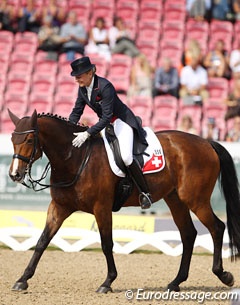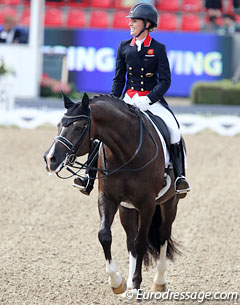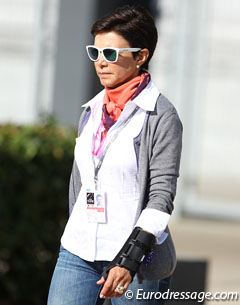
One of the most difficult aspects of top level dressage is of course balancing expression, power, athleticism, and talent with calm, relaxation, peace, harmony. The true art of dressage is being able to get all that power and channel it in a way that is fun for both horse and rider and then produce this in a heightened and compact environment.
The evidence of relaxation and harmony in training is often most evident in a very simple, yet extremely difficult test movement, one that requires not only peace of mind, but also rider relaxation and calm. The free walk!
"The Grand Prix test is so demanding, particularly in that riders are not only asked to produce the highest degree of collection and expression, but also required to produce an extended walk that shows the horse both free and relaxed," says British Olympian Carl Hester. "To create both these things in the atmosphere we are given today, is extremely difficult, as the arenas today are much more electric than they once were."
Feeling that it is very short sighted for critics to point fingers at riders that cannot show a truly relaxed free walk in the test, Carl believes it would be very difficult to explain to such critics what it is like when you ride into the big arenas. "Often we can get the perfect walk outside, and it is not due to fault in the training, more the atmosphere that changes in the test arena," he explained. "Also, the extended walk is so short, not even 60 metres, and often riders find themselves thinking "well if I had 120 metres I'd get the ideal freedom and relaxation in the walk!"
However, Carl finds that if you can create that expression without tension in the test, you can achieve a horse that is in balance, and not pushed against the bit, and therefore produce a supple, relaxed, good quality, extended walk. "For the top marks the extended walk should see a horse with a long neck, length in neck in very important," he added. "Also a horse that is not tense, a horse that will nod the walk out, not back, and then achieve good overtrack and length in the body."
If you cannot get the free walk you want, particularly in the test, Carl suggests extra training, or simply just more experience. "The older, or more experienced the horse, the more likely you will work towards a better and more relaxed walk in competition."
Previous U.S Dressage Team Technical Advisor and international judge Anne Gribbons feels the walk is very important primarily because it is one of the basic gaits and actually the gait that is the most difficult to ride well. "The walk is also the most complicated to improve when there are problems," Gribbons stated. "It is more difficult than the other gaits to get right because there is no impulsion to help the rider get the horse in front of the leg. The rider is therefore more vulnerable at the walk and sometimes leaves it up to the good graces of the horse."
 As we move up the levels riders are required to show different types of walk and what often confuses people is the difference between free walk and extended walk. "At the free walk, the horse is allowed to walk on a loose rein and can stretch his neck at will , while in the extended walk he has to keep the contact with the hand of the rider and march with activity and purpose."
As we move up the levels riders are required to show different types of walk and what often confuses people is the difference between free walk and extended walk. "At the free walk, the horse is allowed to walk on a loose rein and can stretch his neck at will , while in the extended walk he has to keep the contact with the hand of the rider and march with activity and purpose."
According to Anne, riders should focus on the connection staying consistent while allowing the horse to become longer in the neck and on following the rhythm of the walk with a supple seat and soft aids so as to not disturb the motion or the activity of the back. "People often lose marks in this movement because they do not practice the walk often enough," said Anne. "Or they do not realize that the horse has a rhythm problem and actually make the problem worse by not attending to it."
O-judge Maribel Alonso agrees that riders often pay little attention to the walk and that to judges the walk is the gait where the underlying imperfections in a dressage pair become more obvious. "As in every other gait the rhythm and regularity are the most important factor to bear in mind when assessing the walk and both the extended and free walk share the same basic principles," said Alonso. "In the extended walk the horse stretches over the top line keeping the tempo and overtracking all the way across the diagonal, covering as much ground as possible, without losing regularity and without losing activity, maintaining a light but steady contact allowing a natural movement of head/neck with nose in front of the vertical. The horse keeps the straightness and suppleness at the same time showing freedom of shoulders. Both transitions, into and out of the extended walk are part of the movement and they should be smooth and supple without altering the horse's walk rhythm."
Seeing on many occasions the same error Maribel takes marks off when there is no clear difference in the frame and contact in relation to an extended walk. The free walk is a gait of relaxation where the horse is allowed complete freedom, stretching head and neck forward/downward. The same directives in terms of the walk quality, straightness, activity, tempo, natural movement of head and neck apply as well. Here the horses should cover as much ground as possible (more than in the extended walk) and the main difference is the contact which in the free walk is not as relevant. The rider needs to keep the horse's attention and keep it moving through the entire body.
"During the walk the rider should be getting the horse to really relax, moving through its entire body and getting the head and neck forward and downward with a very light contact maintaining the straightness and the consistency of the tempo and the overtracking," said Alonso. "Sometimes riders do not let go, limiting the horse's relaxation and stretching."
 Knowing that the free walk is typically an exercise introduced early on in a horse's competitive career, Maribel feels that many times the horses are tense being out of the usual environment so the riders are scared to let go. "I believe though that it is always worth trying to give the horse the opportunity to relax."
Knowing that the free walk is typically an exercise introduced early on in a horse's competitive career, Maribel feels that many times the horses are tense being out of the usual environment so the riders are scared to let go. "I believe though that it is always worth trying to give the horse the opportunity to relax."
Equally as important as the quality of the free walk itself are the transitions into and out of the free walk. They should also be smooth, without any alteration in the horse's clear walk rhythm. "Also the transitions in and out of the free walk belong to the exercise and sometimes riders forget it," said Maribel. "The horse loses the attention so much and starts going in a slow motion losing the activity that is required."
For the top marks, Maribel advises that riders must aim for a good, smooth and fluent transition into the free walk where the horse immediately stretches forward and downward, keeping its nose in front of the vertical. "The walk rhythm is in 4 clear beat, the horse is moving through its entire body, straight , active and it is covering as much ground as possible, more than in the extended walk (over 3 hoof lengths) stepping in front of footprints of fore legs keeping the same tempo and overtracking. The contact remains light."
There are times while judging some national tests where in the directives it is included either long or loose rein. That will be another element to be taken into consideration and last but not least the transition back to medium or collected walk needs to be as fluent as the transition down to the free walk.
When riding the walk, the worst mistake a rider can make is not riding a clear free walk, and Maribel says if the judge starts to question if this is medium, extended or free walk, then it is not a good beginning. "Also too much contact, hanging on the reins, or getting behind the aids, lazy steps, lacking relaxation, not preparing transitions, horse coming off the bit and dropping the back, and as a result the hind legs cannot step sufficiently under the horse's body."
Olympian Ingrid Klimke agrees and over her thousands of test entries she aims for three simple ingredients to help her achieve that perfect walk freedom. "Relaxation and the neck stretching down. A regular and happy horse," she said.
Text by Sarah Warne for Eurodressage
Photos © Astrid Appels
Related Link
Sarah Warne's Classical Training Articles